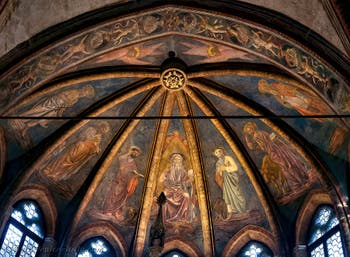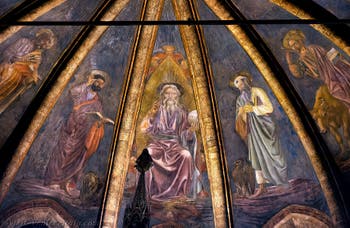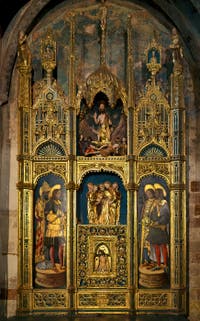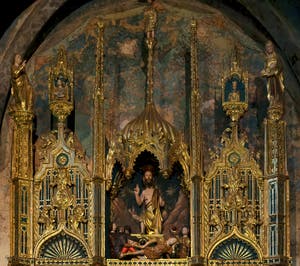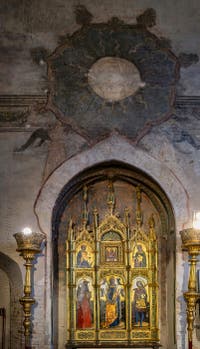Churches Saint-Mark | Miracoli | Stefano | Zaccaria | Murano | Chorus | Mass Hours
San Zaccaria Gothic and Renaissance | Golden Chapel | Opening Hours
San Zaccaria Church in Venice: Chapel Sant Atanasio, San Tarasio Golden Chapel and the Crypt
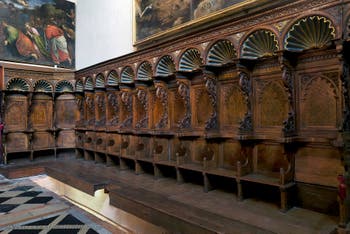
Stalls of chapel of Sant'Atanasio San Zaccaria is a juxtaposition and interlocking of several successive buildings.
The oldest part is on the right side of the current building: it is accessed by the Capella Sant Atanasio, built-in 1595, in the middle nave of the primitive church), where you can admire some magnificent paintings.
Among these are paintings by Giandomenico Tiepolo, Tintoretto and Jacopo Palma Vecchio.
Tintoretto “The Birth of the Virgin” at the Church of San Zaccaria in Venice
Painting - Oil on Canvas (271 x 204 cm) - 1563This superb painting by Tintoretto is located in the chapel of Sant's Atanasio (St. Athanasius) of the church of San Zaccaria.
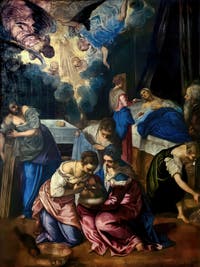
Birth of the Virgin According to art critic Andrea Gallo, it was officially called “Birth of the Baptist”, but it was a mistake.
To justify this mistake in theme, Gallo compares this painting to another work by Tintoretto displayed in the Hermitage Museum in St. Petersburg, which is identified as the “Birth of St. John the Baptist”.
According to Gallo, Tintoretto used the birth of the Virgin's symbols in this painting and cannot in any way refer to the birth of the Baptist.
Indeed, the pyramidal presence of the angels, in the upper left corner of the painting, this opening of heaven towards the child, his celestial illumination, corresponds to the apocryphal description of the birth of Mary as one knew it in the 16th century.
From the moment when Christ chose the Virgin Mary as a receptacle for his coming to earth, at the very moment of his mother's birth, he is already present in the selected form that will give him life.
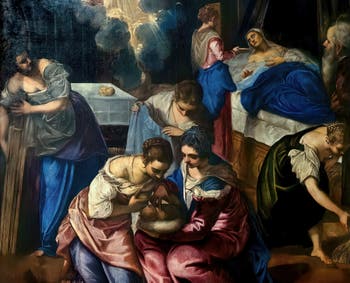
Birth of the Virgin Here is the meaning of this light triangle, of this inverted pyramid whose rays point directly at the newborn in the arms of women.
The sacramental form of the rolled bread on the white tablecloth under the angels is the other symbol highlighted by Tintoretto.
Bread reinforces the thesis of the Virgin's birth because it cannot be linked to that of the Baptist.
Finally, it should be remembered that this picture was intended for a convent of women, which further reinforces the thesis of the subject of Mary's birth.
Since this theological reference has been acquired, the fact remains that this painting is particularly moving.
Indeed, it is a canvas full of life and colour.
How Tintoretto painted the mother and the women nursing the newborn Mary is also lively and modern.
All the art and talent of Tintoretto are present in this work.
Jacopo Palma Il Vecchio “Madonna with Child and Saints”
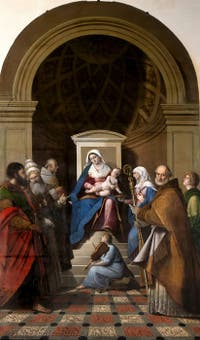
Palma Madonna and Child Painting - Oil on Canvas (Haut x Larg cm) 1512
This painting by Jacopo Palma Il Vecchio (1480 - July 30, 1528) shows the Virgin with the Child Jesus between St. Bernard, Gregory the Great, St. Paul, St. Elizabeth, St. Benedict and St. Placide.
Jacopo Palma Il Vecchio painted a musician angel at the feet of the Virgin as in the painting of “Madonna and Child” (Holy Conversation) by Giovanni Bellini.
He presented his characters in architecture similar to Bellini's, but much more severe and dense, with a dome overcoming the Virgin.
However, there is no landscape here in the background as in the “Holy Conversation” or a symbol of virginity (the hanging ostrich egg) in this painting, made seven years later than Giovanni Bellini's.
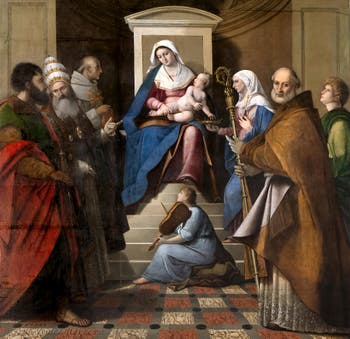
Palma Il Vecchio, Madonna and Child Even if this painting does not reach Bellini's masterpiece's level, it remains excellent pictorial quality.
The saints, as well as the Virgin, are well represented, very present and alive.
But the musician angel, with invisible wings like Bellini's, has a small head relative to his body, disturbing the whole picture.
One can hardly think that Palma Il Vecchio could have made such a mistake.
The most likely hypothesis is that it is not here the artist's original drawing but rather the result of a poor restoration carried out by a painter of a level significantly lower than that of the master.
Giandomenico Tiepolo “The Flight into Egypt” Sant Atanasio San Zaccaria Chapel in Venice
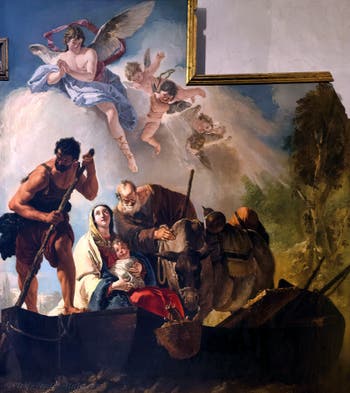
Giandomenico Tiepolo, The Flight into Egypt Painting - Oil on Canvas - Second Half of the 18th Century
“The Flight into Egypt” by Giandomenico Tiepolo (August 30, 1727 - March 3, 1804) is just to the right of the “Birth of the Virgin” of Tintoretto, in the chapel of St. Athanasius.
A painting in line with those of Giambattista Tiepolo, Giandomenico was his eldest son.
Bathed in painting since a young age, he was also the nephew of the Venetian painter Francesco Guardi.
It was, therefore, difficult to escape the profession of a painter with such a circle.
This “Flight into Egypt” of the Church of San Zaccaria is worthy of his father's paintings, bright, dynamic, with present and well-rendered characters. A beautiful painting!
Chapel Sant Atanasio’s Stalls by Francesco and Marco Cozzi
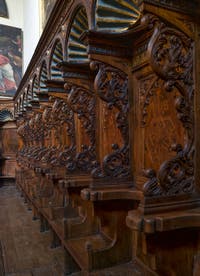
Stalls of chapel of Sant'Atanasio Strangely enough, this chapel, which fortunately has preserved magnificent stalls, which remind us of the origin of its function, looks more like a presbytery room than an actual chapel.
However, it was the central part of the old church of San Zaccaria.
Here, you can also see beautiful stalls made by Francesco and Marco Cozzi, both from Vicenza.
They executed these stalls in San Zaccaria between 1455 and 1464.
The contract entrusted to the two brothers, dated 1455, stated that the nuns wanted this large linear wooden heart similar to those made in the Church of Sant'Elena and the Basilica of San Giovanni and Paolo in Venice.
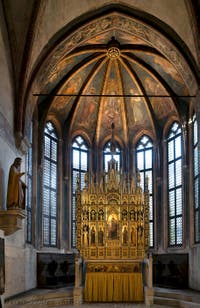
Golden Chapel They are so elegant, with their fine cuts standing out against a blue painted parchment background.
Then you can access the Golden Chapel, which was the old church's presbytery, which then became an apse.
San Tarasio Golden Chapel of San Zaccaria
The Golden Chapel is built in an ogival vault, and it dates to the first half of the 15th century.Important frescoes adorn the apsidal base and vault, painted by Florentine Andrea Del Castagno (1442).
He is also the author of a superb “Last supper” in the Benedictine monastery of Sant's Appolonia in Florence.
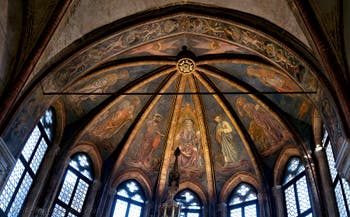
Andrea Del Castagno It is represented on each side of the Eternal Father, St. Zechariah, St. John the Evangelist, St. John the Baptist, St. Matthew and St. Mark.
On the altar and the sides, there are three superb polyptychs in carved and inlaid wood by the marker Ludovico Da Forli (1443) and they house the paintings of Vivarini (1420-1484) and his regular collaborator Giovanni d'Alemagna (died in Venice in 1450).
On the altar, just under the frescoes by Andrea del Castagno, is the “Polyptych of the Virgin”.
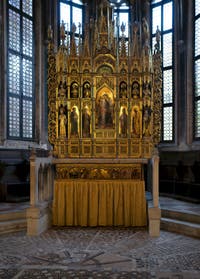
Virgin Polyptych Stefano di Sant'Agnese painted the central panel showing “The Virgin and Child” in 1385, 58 years before everything else.
This central panel is a work of sculpture and painting at the same time, a pure wonder.
This magnificent work is a complex composition in which the characters intermingle and shine with its realization's finesse and beauty.
Wood carvings are painted, as were initially almost all religious sculptures.
Fortunately, their perfect state of conservation allows us to admire this unique piece of art.
So, you see how Venetian artists of the time could be considered among the greatest in Europe.
On the chapel's left are the ”Polyptych of Saint Sabina” and the “Corpus Christi Polyptych” made by Giovanni d'Alemagna and Antonio Vivarini in 1433.
At the foot of the altar, you can see a 12th-century mosaic rediscovered recently.
The Crypt Where Eight of Venice's Oldest Doges Rest
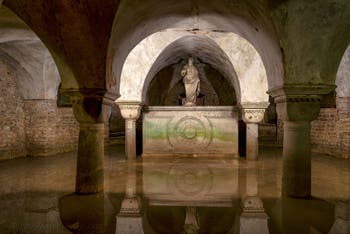
Crypt under the Golden Chapel Under the Golden Chapel is the Crypt, the witness of the first church; a small staircase accesses it.
The construction in Gothic style was juxtaposed with this ancient part of the first church of San Zaccaria.
Between the 9th and 12th centuries, eight of the first Doges of Venice were buried here.
They are now underwater! From a few centimetres to a metre, depending on the tide-making green mark showing the water level as seen in the pictures.
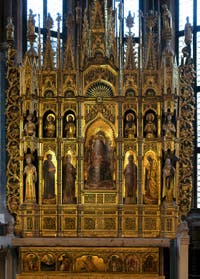
Virgin Polyptych Pietro Tradonico, the “very glorious” Doge Peter, murdered on leaving the church of San Zaccaria in 864, was also buried here.
So, in the Middle Ages, San Zaccaria was a kind of Venetian Pantheon.
When you reach the entrance of this Crypt, often flooded, you can be moved by contemplating those Doges resting under the water and pondering on the significance of this place.
We get a bit of a feeling of being out of time; it stopped here.
A rather elaborate mosaic forms the floor of the Crypt.
San Zaccaria Gothic and Renaissance | Golden Chapel | Opening Hours
Churches Saint-Mark | Miracoli | Stefano | Zaccaria | Murano | Chorus | Mass Hours
Back to Top of Page


